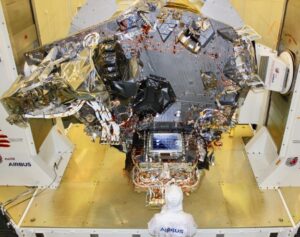The Near Infrared Spectrometer and Photometer (NISP) instrument aims at providing near infrared (between 900 and 2000 nm) photometry of all galaxies observed also with VIS and near infrared low resolution spectra and redshifts of millions galaxies. The near infrared photometry will be combined with VIS data to derive photometric redshifts and rough estimates of distances of galaxies seen by VIS. The near infrared spectra will be used to derive accurate redshifts and distances of galaxies and their 3-dimensional position in the Universe. The NISP spectroscopic data will primarily be used to describe the distribution and clustering of galaxies and how they changed over the last 10 billion years under the effects of the dark matter and dark energy content of the Universe and of gravity.

The Euclid Payload Module during integration. The VIS instrument is clearly visible below. The NISP Instrument is on the left, covered in sheets of multi-layer insulation. Credit: Airbus Defence and Space – Toulouse.
The NISP focal plane is composed of a matrix of 4×4 2040×2040 18 micron pixel Teledyne TIS detectors covering a field of view of 0.53 deg2 shared with VIS, with 0.3 arc-second pixels. The photometric channel will be equipped with 3 broad band filters (Y, J and H) covering the wavelength ranges [900-1192] nm, [1192-1544] nm and [1544-2000] nm, respectively. The spectroscopic channel will be equipped with 4 different low resolution near infrared grisms, 3 “red” (1250 nm – 1850 nm) and 1 “blue” (920 nm – 1250 nm), but no slit (“slitless spectroscopy”). The three red grims will cover the same wavelength range but will provide spectra with three different orientations (0o, 90o and 180o) in order to decontaminate each slitless spectrum from possible overlapping spectra of other sources in the field.
The NISP spectrograph will provide redshift of about 30 million emission line galaxies over the redshift range 0.7 to 2.0 in about 4000 seconds.
